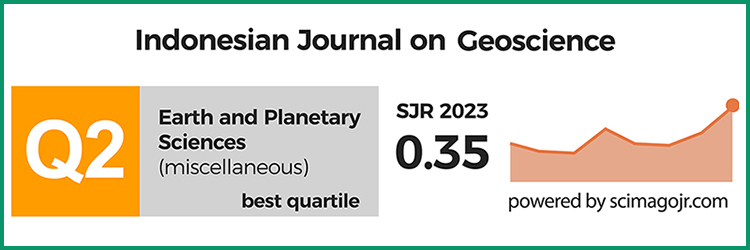Characteristics of Arun Carbonate Reservoir and Its Implication To Optimize the Most Potential Gas Resource Zone In Arun Gas Field, Aceh, Indonesia
DOI:
https://doi.org/10.17014/ijog.6.2.209-222Keywords:
Arun, carbonate, reservoir, gas, resource, petrophysicsAbstract
DOI:10.17014/ijog.6.2.209-222
Since the discovery of major oil and gas reserves in carbonate rocks in the Middle East, carbonate reservoirs became important to the petroleum industry. Carbonate rocks have covered only 20% of the sedimentary rock records. However, carbonate reservoirs hold 50% of the world petroleum reserves. Arun Carbonate Reservoir is one of the biggest proven retrograde gas reservoirs in the world. After more than thirty years of production, Arun Carbonate Reservoir had an initial gas in place of 14.1 TCF residual hydrocarbon gas. The issue makes Arun Carbonate Reservoir became an interest to be studied for the development and production of hydrocarbon in other carbonate reservoirs in Indonesia. One of the fundamental topics to be studied is the characteristics of Arun Carbonate Reservoir itself. The characteristics of carbonate reservoir usually cause a lot of geologic and engineering problems in the development and production of hydrocarbon reserves. This paper aims to identify the characteristics of Arun Carbonate Reservoir and its implication to delineate the potential gas resource zone in the Arun Gas Field, Aceh, Indonesia. The data from sixteen wells have been examined through several multidiscipline studies: geophysics (well logging), geology (facies, lithology and diagenetic analyses), and petrophysics (core analysis). The result of this study shows that Arun Carbonate Reservoir (N5-N8) contains limestone 92%, 5% dolomite, and 3% dolomitic limestone (or other), and petrophysically have 16% porosity and 13.5 md permeability in average. Arun Carbonate Reservoir is divided into four facies (Reef, Near Reef, Inter Reef Lagoon, and Middle Shelf). Of four facies in Arun Carbonate Reservoir, only two facies which can be categorized as productive facies: Reef and Lagoonal Facies. The potential zones of hydrocarbon resources have vertically been documented in Arun Carbonate Reservoir.
References
Afidick, D., Kaczorowski, N.J., and Srinivas B., 1994. Production Performance of a Retrograde Gas Reservoir: A Case Study of the Arun Field. SPE-28749-MS. Asia Pacific Oil and Gas Conference and Exhibition, Melbourne, Australia. DOI:10.2118/28749-MS
Archie, G.E., 1952. Classification of Carbonate Reservoir Rocks and Petrophysical Considerations. AAPG Bulletin, 36 (2), p.278-298. DOI:10.1306/3d9343f7-16b1-11d7-8645000102c1865d
Atmadibrata, R.M.R. and Joenoes, S., 1993. Vertical Horizontal Permeability Relationship: Arun Reservoir. SPE-25362-MS, Asia Pacific Oil and Gas Conference and Exhibition, Singapore. DOI:10.2118/25362-MS
Atmadibrata, R.M.R., 1988. Top of Abnormal Pressure Zone Prediction in the Arun Field, North Sumatra. PIT. IAGI XVII, Jakarta.
Avida, H., Auzan A.S., and Deli P.U., 2013. Aceh Operation Mature Field Management: Arun Assets Consolidation and North Sumatra Offshore (NSO) Liquid Handling. SPE-165929-MS, Asia Pacific Oil and Gas Conference and Exhibition, Jakarta, Indonesia. DOI:10.2118/165929-MS
Barber, A.J., Crow, M.J., and Milsom, J.S. 2005. Sumatra: Geology, Resources, and Tectonic Evolution. Geology Society Memoirs, 31, London, 289p. DOI:10.1017/s0016756806212974
Cameron, N.R., Bennett, J.D., Bridge, D.McC., Clarke, M.C.G., Djunuddin, A., Ghazali, S.A., Harahap, H., Jeffery, D.H., Kartawa, W., Keats, W., Ngabito, H., Rocks, N.M.S., and Thompson, S.J., 1983. Geologic Map of the Takengon Quadrangle, Sumatra, scale 1:250.000. GRDC, Bandung.
Chilingarian, G.V., Mazzullo, S.J., and Rieke, H.H., 1992. Carbonate Reservoir Characterization: A Geologic - Engineering Analysis, Part I, Elsevier, Amsterdam, 638p. DOI:10.1016/s0376-7361(96)80023-9
Chopra, S., Chemingui, N., and Miller, R., 2005. An Introduction to this Special Section Carbonates. The Leading Edge May, p.488-489. DOI:10.1190/1.1926805
Choquette, P.W. and Pray, L.C., 1970. Geological Nomenclature and Classification of Porosity in Sedimentary Carbonates. AAPG Bulletin, 54, p.207-250. DOI:10.1306/5d25c98b-16c1-11d7-8645000102c1865d
Fauzi, R.R., Atmadibrata R.M.R., Muslim, D., and Sophian, R.I., 2017. Physical and Geomechanical Characteristics of Keutapang Formation in Arun Gas Field, North Sumatra, Indonesia. Proceedings the 2nd Joint Conference of Utsunomiya University and Universitas Padjajaran, Japan.
Jordan C.F., 1989. The Geology of the Arun Reservoir: Depositional and Diagenetic History of a Miocene Patch Reef Complex, North Sumatra, Indonesia. Mobil Research & Development Corporation, Unpublished Report.
Keats, W., Cameron, N.R., Djunuddin, A., Ghazali, S.A., Harahap, H., Kartawa, W., Ngabito, H., Rocks, N.M.S., Thompson, S.J., and Whandoyo, R., 1981. Geologic Map of the Lhokseumawe Quadrangle, Sumatra, scale 1:250.000. GRDC, Bandung.
Kong, L., Wan, M., Yan, Y., Zou, C., Liu, W., Tian, C., Yi, L., and Zhang, J., 2016. Reservoir Diagenesis Research of Silurian Longmaxi Formation in Sichuan Basin, China. Journal of Natural Gas Geoscience, I, p.203-211. DOI:10.1016/j.jnggs.2016.08.001
Lindsay, R.F., 2010. Carbonate Porosity Families and Their Reservoir Potential, Louisiana USA. AAPG Annual Convention and Exhibition.
Lucia, F.J., 1995. Rock Fabric Petrophysical Classification of Carbonate Pore Space for Reservoir Characterization. AAPG Bulletin, 79, p.1275-1300. DOI:10.1306/7834d4a4-1721-11d7-8645000102c1865d
Lucia, F.J., 2007. Carbonate Reservoir Characterization. 2nd edition Springer-Verlag, Berlin, 342p. DOI:10.1007/978-3-540-72742-2
Mazzullo, S.J., 2004. Overview of Porosity Evolution in Carbonate Reservoirs. Kansas Geological Society Bulletin,79 (1-2), p.1-19.
Moore, C.H., 2001. Carbonate Reservoirs: Porosity Evolution and Diagenesis in a Sequence Stratigraphic Framework. Elsevier, Amsterdam, 444p.
North, F.K., 1985. Petroleum Geology. Allen & Unwin, London, 607p.
Praptisih and Kamtono, 2014a. Hydrocarbon Host Rock Characteristics of Cibulakan Formation at Palimanan Area, Cirebon, West Java. Buletin Sumberdaya Geologi, 9 (1), p.27-40.
Praptisih and Kamtono, 2014b. Carbonate Facies and Sedimentation of the Klapanunggal Formation in Cibinong, West Java. Indonesian Journal on Geoscience, I (3), p.175-183. DOI:10.17014/ijog.v1i3.196
Schon, J.H., 2011. Physical Properties of Rocks: A Workbook. Handbook of Petroleum Exploration and Production, Elsevier, UK, 481p.
Serra, O., 2003. Well-log and Geology. Elsevier Science Publishing Company inc. USA, 468p.
Soeparjadi, R.A., 1983. Geology of the Arun Gas Field. SPE Paper No. 10486. Presented at Offshore South East Asia Conference, Singapore.
Wardlaw, N.C., 1976. Pore geometry of carbonate rocks as revealed by pore casts and capillary pressures. AAPG Bulletin, 60, p.245-257. DOI:10.1306/83d922ad-16c7-11d7-8645000102c1865d
Wayne, M.Ahr., 2008. Geology of Carbonate Resevoirs: The Identification, Description and Charaterization of Hydrocarbon Reservoirs in Carbonate Rocks. Willey, New Jersey, 289pp. DOI:10.1002/9780470370650



















